
Turquoise
comes in all shades of blue, to blue-green, with a possible
shading towards brown-veined greens. It is the natural variations in turquoise
that make it appealing. The color of turquoise in American Indian jewelry ranges
from brownish green to bright blue. 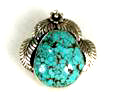 Found
in veins sandwiched in between layers of mother rock, the turquoise can
show some of the influence of the mother rock in its matrix or veining. The matrix
colors range from blue to golden brown to black and sometimes with golden flecks
(sometimes called "fools gold" or iron pirite) which is very desirable. Found
in veins sandwiched in between layers of mother rock, the turquoise can
show some of the influence of the mother rock in its matrix or veining. The matrix
colors range from blue to golden brown to black and sometimes with golden flecks
(sometimes called "fools gold" or iron pirite) which is very desirable.
The more blue, the higher the copper
content. The more green, the higher the iron content.
 Sometimes
turquoise is cut so that it takes some of the mother rock with it. This is referred
to as "Boulder Turquoise" and it is very popular as it shows
great contrast between the turquoise and the surrounding rock with which it formed. Sometimes
turquoise is cut so that it takes some of the mother rock with it. This is referred
to as "Boulder Turquoise" and it is very popular as it shows
great contrast between the turquoise and the surrounding rock with which it formed.
Types
of TurquoiseNot All Turquoise is Created
EqualIf you are looking at two turquoise
bracelets one at $30 and the other at $500, what is the difference? Well, there
are many uses and misuses of the word turquoise. Natural
Turquoise is a stone that has not been altered in any way. It is the way it
was  found
in nature. Natural Turquoise looks very real and beautiful but, over time, when
exposed to light, sweat, perfume, makeup, oils and detergents, it can deteriorate
(crumble) and lose its color or change color to a pale green. It can also lose
its structural stability and crumble and crack. To deal with these problems, methods
have been developed to preserve turquoise. Manufacturers and dealers use the following
terms in a non-standard fashion, so if you are ever in doubt when purchasing a
turquoise item, you should ask about the origin of the turquoise and its treatment. found
in nature. Natural Turquoise looks very real and beautiful but, over time, when
exposed to light, sweat, perfume, makeup, oils and detergents, it can deteriorate
(crumble) and lose its color or change color to a pale green. It can also lose
its structural stability and crumble and crack. To deal with these problems, methods
have been developed to preserve turquoise. Manufacturers and dealers use the following
terms in a non-standard fashion, so if you are ever in doubt when purchasing a
turquoise item, you should ask about the origin of the turquoise and its treatment. Enhanced
usually refers to a natural stone that has been treated with electrical currents
that hardens the stone and enhances the color. Nothing else is done to the stone.
Enhanced turquoise should not change color over time.
Stabilized
turquoise has been impregnated with an acrylic or epoxy to harden the stone and
preserve the color. Almost all turquoise used for Native American jewely, especially
for heishi and fetish carvings is stabilized because otherwise the stones would
likely fade and break.  Mojave
Turquoise is a man-enhanced or composite stone made from turquoise from the
Kingman mine in Mohave County, Arizona. Blue Kingman turquoise is infused with
resin or polymer to increase its durability and then dyed. After dyeing, the stone
is fused with bronze or copper to fill gaps and accent veins in the stone. The
Kingman turquoise mine is the only mine authorized to process turquoise in this
manner for genuine Mojave Turquoise. Mojave
Turquoise is a man-enhanced or composite stone made from turquoise from the
Kingman mine in Mohave County, Arizona. Blue Kingman turquoise is infused with
resin or polymer to increase its durability and then dyed. After dyeing, the stone
is fused with bronze or copper to fill gaps and accent veins in the stone. The
Kingman turquoise mine is the only mine authorized to process turquoise in this
manner for genuine Mojave Turquoise.
Compressed
stones have been hardened by extreme pressure.  Fracture-Sealing
uses resin or polymer to harden the matrix in the stone. (Matrix is other
minerals mixed in the turquoise or portions of the "mother rock" in
which the turquoise formed. Matrix appears in the turquoise as uneven areas of
brown or black). Fracture-Sealing
uses resin or polymer to harden the matrix in the stone. (Matrix is other
minerals mixed in the turquoise or portions of the "mother rock" in
which the turquoise formed. Matrix appears in the turquoise as uneven areas of
brown or black).
Artificial or Imitation
Turquoise - There are a number of manufactured turquoise products, some of which
look like real stone and others that look like plastic. Some minerals, like howlite,
can be dyed to look like turquoise. Synthetic
and Lab Grown Turquoise have the same chemical composition and physical
look of natural turquoise. Block Turquoise
is manufactured in blocks and is made to look like turquoise. It may be all plastic
polymer or it may have crushed or powdered turquoise or other stone mixed with
resin or polymer. Block Turquoise sometimes has swirls or blobs of dark dye added
to simulate the look of matrix. 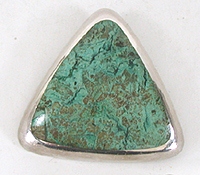 "African
Turquoise" is actually a type of jasper that has
black and brown matrix and veining resembling that of true turquoise. It is treated
with blue and green dyes to make it resemble the colors of natural turquoise. "African
Turquoise" is actually a type of jasper that has
black and brown matrix and veining resembling that of true turquoise. It is treated
with blue and green dyes to make it resemble the colors of natural turquoise.
Turquoise Patterns 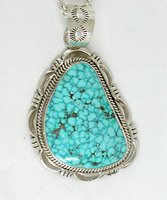
Birdseye
Turquoise is a term that describes turquoise made up of many small turquoise
nuggets surrounded by a darker blue matrix. It is similar to Spiderweb Turquoise,
but spiderweb has a dark matrix. Read
more . . .  Boulder
Turquoise, also called Ribbon Turquoise, refers to how the stone is
cut, not where it comes from. Turquoise forms in veins of various widths within
boulders, or "mother rock". Most often these veins are cut out of the surrounding
rock to harvest pure turquoise pieces. But when the stone is cut to show the mother
rock as the main feature with the original vein or ribbon of turquoise running
through it as an accent it is called Boulder Turquoise. Boulder
Turquoise, also called Ribbon Turquoise, refers to how the stone is
cut, not where it comes from. Turquoise forms in veins of various widths within
boulders, or "mother rock". Most often these veins are cut out of the surrounding
rock to harvest pure turquoise pieces. But when the stone is cut to show the mother
rock as the main feature with the original vein or ribbon of turquoise running
through it as an accent it is called Boulder Turquoise.
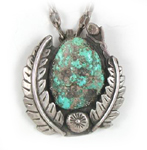 Seafoam,
The term Seafoam Turquoise does not refer to a mine or location where certain
turquoise is found. Rather it refers to two visual characteristics that turquoise
nuggets might have. The turquoise could come from any number of mines. Seafoam
refers to both color and shape. It is meant to look like the configuration of
bubbling foam at the seaside, so bumpy turquoise in the seafoam color, a pale
frothy green. Read
more. Seafoam,
The term Seafoam Turquoise does not refer to a mine or location where certain
turquoise is found. Rather it refers to two visual characteristics that turquoise
nuggets might have. The turquoise could come from any number of mines. Seafoam
refers to both color and shape. It is meant to look like the configuration of
bubbling foam at the seaside, so bumpy turquoise in the seafoam color, a pale
frothy green. Read
more.

Spiderweb
Turquoise Spiderweb Turquoise is a term used to describe turquoise that looks
like a spiderweb. It is not associated with any one mine, but many mines, some
of the most notable being Kingman, Number 8, Lander Blue, Lone Mountain, Candelaria
and others. Read
more . . .
 China
Mountain Turquoise [Dragon Skin - Blue Ridge, Cloud Mountain, Emperor's Turquoise],
as its name implies, comes from China. Like mines in other parts of the world,
including the USA, mines in China produce turquoise of varying quality and in
a wide variety of color and matrix variations. Turquoise from China is usually
stabilized (treated with clear epoxy) to harden and seal it. This makes the turquoise
more durable and minimizes absorbtion of body oils and other substances that might
change the color of the stone over time. China
Mountain Turquoise [Dragon Skin - Blue Ridge, Cloud Mountain, Emperor's Turquoise],
as its name implies, comes from China. Like mines in other parts of the world,
including the USA, mines in China produce turquoise of varying quality and in
a wide variety of color and matrix variations. Turquoise from China is usually
stabilized (treated with clear epoxy) to harden and seal it. This makes the turquoise
more durable and minimizes absorbtion of body oils and other substances that might
change the color of the stone over time.
Some
of the turquoise mines in the USA Bisbee
turquoise was a by-product of copper mining near Bisbee, Arizona. It is known
mainly for its brilliant blue color and smoky webbing. Bisbee turquoise was found
at all levels of the copper mine from 100 to 2000 feet and the quality and coloration
varies widely from layer to layer. Often the stones have a matrix of brown, gray
or black, but clear stones of blues and greens have also come from the Bisbee
mine. There was never that much turquoise mined in Bisbee to begin with and now
the mine is closed. What remains today is in the hands of old miners and long-time
collectors. Because of its hardness, quality and scarcity Bisbee turquoise is
one of the most valued turquoise in the world today. Bisbee
turquoise was a by-product of copper mining near Bisbee, Arizona. It is known
mainly for its brilliant blue color and smoky webbing. Bisbee turquoise was found
at all levels of the copper mine from 100 to 2000 feet and the quality and coloration
varies widely from layer to layer. Often the stones have a matrix of brown, gray
or black, but clear stones of blues and greens have also come from the Bisbee
mine. There was never that much turquoise mined in Bisbee to begin with and now
the mine is closed. What remains today is in the hands of old miners and long-time
collectors. Because of its hardness, quality and scarcity Bisbee turquoise is
one of the most valued turquoise in the world today.

Blue
Diamond (central Nevada) operated from the late 1950ís to 1980. This stone
typically has dark smoky swirls with brilliant blue windows. 
Blue
Gem (Contention, Battle Mountain)
near Battle Mountain in Lander County,
Nevada. It was discovered in 1934 and at 800 feet deep was the deepest turquoise
mine in the state. Produced high quality blue to blue green turquoise with some
being partly translucent or "glassy" in appearance.  Blue
Ridge (Crescent Valley, northern Nevada) Also called the Orvil Jack Mine
after the miner who discovered and developed it. At first Jack mined only for
the bright blue turquoise and discarded the green stones. Now the yellow-green
turquoise (which results from the high zinc content) is quite rare and consequently
very collectible. Blue
Ridge (Crescent Valley, northern Nevada) Also called the Orvil Jack Mine
after the miner who discovered and developed it. At first Jack mined only for
the bright blue turquoise and discarded the green stones. Now the yellow-green
turquoise (which results from the high zinc content) is quite rare and consequently
very collectible.

Candelaria turquoise was mined in parts of the large Candelaria Open Pit
Copper, Silver, and Gold Mine in the Candelaria Hills area near Tonopah, Nevada.
Very little information can be found about Candelaria turquoise in the mining
literature. High-grade Candelaria turquoise is a hard stone, translucent dark
blue with a redish brown spiderweb matrix. The finest turquoise was found in places
so difficult to work that it was almost unattainable. The mine is now closed and
its scarcity makes it very collectible.
 Carico
Lake turquoise comes from a dry lake bed in Lander County, Nevada. Known mainly
for its gold mining operations, Carico Lake is at about 5000 foot elevation, higher
than most turquoise mines. The beautiful stones are green because of their high
zinc content and are usually described as spring green or Irish green. Carico
Lake turquoise comes from a dry lake bed in Lander County, Nevada. Known mainly
for its gold mining operations, Carico Lake is at about 5000 foot elevation, higher
than most turquoise mines. The beautiful stones are green because of their high
zinc content and are usually described as spring green or Irish green.
Cerrillos
- The Cerrillos Hills Mining District south of Santa Fe, New Mexico encompasses
many mines, the two largest being Mount Chalchihuitl and Turquoise Hill. Mount
Chalchihuitl was mined for turquoise by Native Americans as early as 900 A.D.
and is the site of the largest single deposit of turquoise ever found in North
America. Cerrillos turquoise varies in color from sky blue to blue greens to pure
green. Specimens often contain streaks of limonite and bright specks of pyrite. Cripple
Creek (Teller County, Colorado) Green and blue with brown matrix; by-product
of gold mining.  Crow
Springs Turquoise Mine (AnnJax, Bluebird) is located near Tonopah, Nevada.
It is only about 30 miles from the more famous Royston Mine. Crow Springs
is known for stone having light green color with a bright red matrix (rhyolite).
Crow Springs turquoise occurs in veins ranging from paper-thin to nearly half
an inch thick. Large gems are rare and prized. The best smaller stones have good
color and are very hard. Crow
Springs Turquoise Mine (AnnJax, Bluebird) is located near Tonopah, Nevada.
It is only about 30 miles from the more famous Royston Mine. Crow Springs
is known for stone having light green color with a bright red matrix (rhyolite).
Crow Springs turquoise occurs in veins ranging from paper-thin to nearly half
an inch thick. Large gems are rare and prized. The best smaller stones have good
color and are very hard.
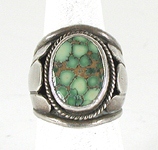 The
Damele Mine (also known as Damali), located in east central Nevada
near the Carico Lake mine, is noted for hard, yellow-green turquoise. The
webbed matrix is dark brown to black. The Damele mine is small and its turquoise
is of a rare color making it a very collectible turquoise. The
Damele Mine (also known as Damali), located in east central Nevada
near the Carico Lake mine, is noted for hard, yellow-green turquoise. The
webbed matrix is dark brown to black. The Damele mine is small and its turquoise
is of a rare color making it a very collectible turquoise.  Dry
Creek (Battle Mountain, Nevada) Very pale blue color because there is very
little copper or iron in the ground where it forms. Stones from the same mine
that are white, with no trace of blue or green color, are called White Buffalo
Stone because the white buffalo is a very rare and sacred buffalo. Read
more... Dry
Creek (Battle Mountain, Nevada) Very pale blue color because there is very
little copper or iron in the ground where it forms. Stones from the same mine
that are white, with no trace of blue or green color, are called White Buffalo
Stone because the white buffalo is a very rare and sacred buffalo. Read
more...
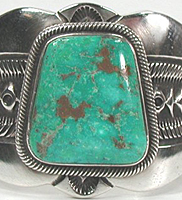 EASTER
BLUE An old Nevada mine owned and operated by Danny
and Dean Otteson. It is located in Nye County near the Royston turquoise area.
In was opened in 1907 and produces turquoise from surface and underground mines.
The turquoise is hard, of fine quality and a rich blue color with beautiful matrix. EASTER
BLUE An old Nevada mine owned and operated by Danny
and Dean Otteson. It is located in Nye County near the Royston turquoise area.
In was opened in 1907 and produces turquoise from surface and underground mines.
The turquoise is hard, of fine quality and a rich blue color with beautiful matrix.
 Fox
Turquoise mine (Lander County, Nevada) discovered in the early 1900ís, was
once Nevadaís largest producer of green or blue-green turquoise with a distinctive
matrix. Fox turquoise is quite hard and varies from shades of green to aqua blue.The
different sites of Fox deposits were developed using the names of Fox, White Horse,
Green Tree, and Smith to differentiate among the colors of turquoise produced
in the area and to create a larger perceived share of the market. Fox
Turquoise mine (Lander County, Nevada) discovered in the early 1900ís, was
once Nevadaís largest producer of green or blue-green turquoise with a distinctive
matrix. Fox turquoise is quite hard and varies from shades of green to aqua blue.The
different sites of Fox deposits were developed using the names of Fox, White Horse,
Green Tree, and Smith to differentiate among the colors of turquoise produced
in the area and to create a larger perceived share of the market.
 Kingman
Mine, located in Mohave County, Arizona, has been operated
by the Colbaugh family since the 1970's. It is known for producing bright blue
stones with white and black matrix, considered by many to be the best turquoise
in North America. Old authentic natural Kingman turquoise
is extremely rare. Kingman
Mine, located in Mohave County, Arizona, has been operated
by the Colbaugh family since the 1970's. It is known for producing bright blue
stones with white and black matrix, considered by many to be the best turquoise
in North America. Old authentic natural Kingman turquoise
is extremely rare.
In the 1950s S. A. "Chuck"
Colbaugh developed a modern method for stabilizing the color and strength of turquoise.
It is an expensive process that takes over 3 months to assure that the turquoise
does not crack while being treated. Basically, the moisture is removed from the
stone and replaced with an optically clear resin, the same type as used in jet
fighter windows. The turquoise is then allowed to dry naturally for two to three
months. Although other mines have turquoise stabilization
facilities, those at the Kingman mine are widely regarded as the best. Marty
Colbaugh (Chuck Colbaugh's grandson) now runs the Kingman mine and continues the
stabilizing tradition began by his grandfather. He says if natural turquoise is
not treated, it can become oxidized with oils from the skin and change color.
The products that Kingman uses for stabilizing turquoise are clear and no dyes
are ever used so the natural turquoise color is preserved and no discoloration
occurs.  Kingman
Mojave Turquoise is a man-enhanced or composite stone made from turquoise
from the Kingman mine in Mohave County, Arizona. Blue Kingman turquoise is infused
with resin or polymer to increase its durability and then dyed. After dyeing,
the stone is fused with bronze or copper to fill gaps and accent veins in the
stone. The Kingman turquoise mine is the only mine authorized to process turquoise
in this manner for genuine Mojave Turquoise. Kingman
Mojave Turquoise is a man-enhanced or composite stone made from turquoise
from the Kingman mine in Mohave County, Arizona. Blue Kingman turquoise is infused
with resin or polymer to increase its durability and then dyed. After dyeing,
the stone is fused with bronze or copper to fill gaps and accent veins in the
stone. The Kingman turquoise mine is the only mine authorized to process turquoise
in this manner for genuine Mojave Turquoise.
 King's
Manassa (Conejos County, Colorado) is best known for its brilliant greens
and golden and brown non-webbed matrices, but blue and blue-green stone is found
there as well. This site, east of the town of Manassa, was originally mined by
Ancestral Pueblo peoples. It was rediscovered in 1890 by gold prospector I.P.
King, and his descendants still work the claim. King's
Manassa (Conejos County, Colorado) is best known for its brilliant greens
and golden and brown non-webbed matrices, but blue and blue-green stone is found
there as well. This site, east of the town of Manassa, was originally mined by
Ancestral Pueblo peoples. It was rediscovered in 1890 by gold prospector I.P.
King, and his descendants still work the claim.
Lander
Blue (Lander County, Nevada). Lander Blue turquoise is known for high quality
medium to deep blue color with black spiderweb matrix. Some stones appear predominantly
black speckled with bright blue. This turqoise deposit was discovered in 1973
by a blackjack dealer who sold the claim to two men who formed Lander Blue Turquoise
Corporation. The small deposit it was referred to as a "hat mine", a term used
to describe floats of turquoise so small they could be “covered with a hat”.
Less than 150 pounds of high grade spiderweb turquoise has ever been taken from
the mine, making it one of the rarest and most valuable turquoise in the world.
Lone Mountain (Esmeralda County,
Nevada). Deep blue stones with fine spider webs.

Morenci
Turquoise came out of the Morenci Copper Mine in southeastern Arizona, the
largest copper mine in the United States. The most valued stones range from light
blue to bright blue. Some stones have an irregular matrix of quartz and pyrite
(fool's gold), which resembles silver when polished. Other stones have a brown
matrix called "Morenci red matrix". Because of its scarcity and beautiful colors
Morenci Turquoise is highly prized..
New
Lander Turquoise Mine is in northern Nevada across a valley from the original
Lander Blue mine. It produces turquoise with wild patterns and color characteristics.
Some stones called New Landers or Royal Web are predominantly black speckled with
bright blue. Other stones called Yellow Web are black mottled with brown.  Nevada
Green Turquoise. Many Turquoise mines throughout Nevada produce beautiful
shades of green turquoise ranging from lime green to a rich dark green. Some of
the more famous mines are the Royston, Blue Gem, Orvil Jack, Carico Lake, Battle
Mountain, Pilot Mountain, and the Fox mine. Nevada Green Turquoise has been popular
among jewelry collectors for generations, Today it has become scarce due to a
slow down in Nevada turquoise mining caused by government restrictions and rising
costs of mining. Nevada
Green Turquoise. Many Turquoise mines throughout Nevada produce beautiful
shades of green turquoise ranging from lime green to a rich dark green. Some of
the more famous mines are the Royston, Blue Gem, Orvil Jack, Carico Lake, Battle
Mountain, Pilot Mountain, and the Fox mine. Nevada Green Turquoise has been popular
among jewelry collectors for generations, Today it has become scarce due to a
slow down in Nevada turquoise mining caused by government restrictions and rising
costs of mining.
 Number
Eight (Carlin, Nevada) Exceptional spiderweb turquoise ranging in color from
light blue, to blue and green to deep blue. The matrix is black, brown, reddish
or golden with the black and red spiderwebbing being the most prized. with the
matrix ranging from golden brown to almost black, but a deep golden webbing is
most characteristic. The mine began in 1929 and has produced some of the largest
turquoise nuggets ever found. Number
Eight (Carlin, Nevada) Exceptional spiderweb turquoise ranging in color from
light blue, to blue and green to deep blue. The matrix is black, brown, reddish
or golden with the black and red spiderwebbing being the most prized. with the
matrix ranging from golden brown to almost black, but a deep golden webbing is
most characteristic. The mine began in 1929 and has produced some of the largest
turquoise nuggets ever found.
Orvil
Jack (see Blue Ridge) 
Pilot
Mountain Turquoise Mine in Esmeralda County, Nevada, produces deep blue and
green stones with dark brown, reddish or black matrices. One stone can show color
graduations from light blue to dark green, which makes this turquoise very collectible.
Pilot Mountain turquoise is very hard and takes a high polish.
Persian (Iranian) Turquoise has been mined for more than 4000 years. It
is found in a variety of colors and matrix patterns. It is often rich blue and
distinguished by white flecks or patches. Throughout history, the most prized
Persian turquoise has been brilliant sky-blue with no evidence of green nor any
black veins, similar to the famed Sleeping Beauty turquoise of the southwest United
States.  Royston
turquoise mine district (Nye County, Nevada) consists of several mines including
Royston, Royal Blue, Oscar Wehrend and Bunker Hill. Discovered in 1902 it is the
oldest patented mine in Nevada. Royston turquoise is known
for its beautiful deep green to rich light blue colors in the same formation and
the stones are often two-tone, displaying both dark and light green and sometimes
blue. It has a heavy matrix ranging from dark brown to gold in color. Royston
turquoise is considered very collectible. Royston
turquoise mine district (Nye County, Nevada) consists of several mines including
Royston, Royal Blue, Oscar Wehrend and Bunker Hill. Discovered in 1902 it is the
oldest patented mine in Nevada. Royston turquoise is known
for its beautiful deep green to rich light blue colors in the same formation and
the stones are often two-tone, displaying both dark and light green and sometimes
blue. It has a heavy matrix ranging from dark brown to gold in color. Royston
turquoise is considered very collectible.
Sierra
Nevada Turquoise is mined in the the Candelaria hills of the Sierra Nevada
Mountains near Tonopah, Nevada, not far from the Royston and Candelaria turquoise
mines. Sierra Nevada Turquoise is found in a wide variety of colors from brilliant
light blues, to mixed blues to vibrant dark green. Matrix colors include brown,
gold and black with patterns ranging from fine lines to thick lines and including
irregular patches. 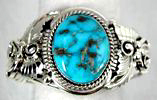 Sleeping
Beauty (Globe in Gila County, Arizona) Uniform blue turquoise that is easily
matched and cut. Often clear but sometimes with white matrix that is dyed black. Sleeping
Beauty (Globe in Gila County, Arizona) Uniform blue turquoise that is easily
matched and cut. Often clear but sometimes with white matrix that is dyed black.
 Sunnyside
mine in northeast Nevada has produced some of the finest turquoise to be found
anywhere. It is known for its extreme hardness and a distinct spiderweb matrix
ranging from golden brown to black. The turquoise color range includes dark to
light blue, green and blue-green. Sunnyside turquoise was mined mostly in the
1970ís and has since been closed, so the only specimans available are from old
stashes, which makes it more valuable. Sunnyside
mine in northeast Nevada has produced some of the finest turquoise to be found
anywhere. It is known for its extreme hardness and a distinct spiderweb matrix
ranging from golden brown to black. The turquoise color range includes dark to
light blue, green and blue-green. Sunnyside turquoise was mined mostly in the
1970ís and has since been closed, so the only specimans available are from old
stashes, which makes it more valuable. Stormy
Mountain (Elko County, Nevada) Dark blue with black matrix looking like blotches.
 Turquoise
Mountain (Mohave County, Arizona) Although located near the Kingman Mine,
the Turquoise Mountain Mine has stones different in appearance
from other Kingman area turquoise. Also known as Old Man Turquoise its color varies
from light to high blue to blue-green and has often been found with a golden or
rust colored spider webbing. The mine has produced "birdseye" stones
that show areas of light blue circled with dark blue matrix, resembling the eye
of a bird .The mine was closed in the 1980s. Turquoise
Mountain (Mohave County, Arizona) Although located near the Kingman Mine,
the Turquoise Mountain Mine has stones different in appearance
from other Kingman area turquoise. Also known as Old Man Turquoise its color varies
from light to high blue to blue-green and has often been found with a golden or
rust colored spider webbing. The mine has produced "birdseye" stones
that show areas of light blue circled with dark blue matrix, resembling the eye
of a bird .The mine was closed in the 1980s.
 White Buffalo (sometimes erroneously called "White
Turquoise) is a form of dolomite
(dolostone) that is very hard and is pure white with black inclusions. It
is similar to, but harder than, limestone. White Buffalo is mined near Tonopah,
Nevada by the Otteson family. Howlite, a softer more porous black and white stone,
is commonly passed off as White Buffalo Stone. Read:
White Turquoise Demystified to learn all the details.
White Buffalo (sometimes erroneously called "White
Turquoise) is a form of dolomite
(dolostone) that is very hard and is pure white with black inclusions. It
is similar to, but harder than, limestone. White Buffalo is mined near Tonopah,
Nevada by the Otteson family. Howlite, a softer more porous black and white stone,
is commonly passed off as White Buffalo Stone. Read:
White Turquoise Demystified to learn all the details.
|